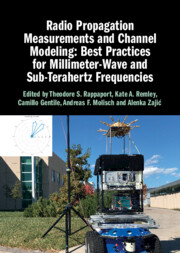Book contents
- Frontmatter
- Dedication
- Contents
- Contributors
- Preface
- 1 Introduction
- 2 Estimating Channel Characteristics from Measurements
- 3 Channel Sounders
- 4 Verification Techniques
- 5 Introduction to Millimeter-Wave Channel Modeling
- 6 Path Loss/Shadowing
- 7 Multipath Component Clustering
- 8 Dispersion Characteristics
- 9 Peer-to-Peer Networking
- 10 Temporal Variance: Literature Review on Human Blockage Models
- 11 Terahertz Channels
- 12 Connection between the Measurements and Models
- 13 Conclusions
- Index
4 - Verification Techniques
Published online by Cambridge University Press: 18 August 2022
- Frontmatter
- Dedication
- Contents
- Contributors
- Preface
- 1 Introduction
- 2 Estimating Channel Characteristics from Measurements
- 3 Channel Sounders
- 4 Verification Techniques
- 5 Introduction to Millimeter-Wave Channel Modeling
- 6 Path Loss/Shadowing
- 7 Multipath Component Clustering
- 8 Dispersion Characteristics
- 9 Peer-to-Peer Networking
- 10 Temporal Variance: Literature Review on Human Blockage Models
- 11 Terahertz Channels
- 12 Connection between the Measurements and Models
- 13 Conclusions
- Index
Summary
Channel sounder verification ensures that participants measure and report channel characteristics that are due to the environment as opposed to measurement artifacts arising from the use of a suboptimal configuration, from nonidealities in the sounder hardware, or from errors in analysis and/or postprocessing. The participants in the 5G mmWave Channel Model Alliance have established a channel sounder verification program. The program allows labs to compare their measured, processed data to theory or to an artifact having known characteristics. Three types of verification are illustrated: “in-situ,” “controlled condition,” and “comparison-to-reference” verification.
Keywords
Information
- Type
- Chapter
- Information
- Radio Propagation Measurements and Channel Modeling: Best Practices for Millimeter-Wave and Sub-Terahertz Frequencies , pp. 43 - 90Publisher: Cambridge University PressPrint publication year: 2022
